U.S. Employment Downtrend Continues, Recession Not Over Yet
Stock-Markets / Financial Markets 2009 Jun 06, 2009 - 07:35 AM GMT Nonfarm payroll employment fell by 345,000 in May, about half the average monthly decline for the prior 6 months, the Bureau of Labor Statistics of the U.S. Department of Labor reported today. The unemployment rate continued to rise, increasing from 8.9 to 9.4 percent. Steep job losses continued in manufacturing, while declines moderated in construction and several service-providing industries.
Nonfarm payroll employment fell by 345,000 in May, about half the average monthly decline for the prior 6 months, the Bureau of Labor Statistics of the U.S. Department of Labor reported today. The unemployment rate continued to rise, increasing from 8.9 to 9.4 percent. Steep job losses continued in manufacturing, while declines moderated in construction and several service-providing industries.
Since the start of the recession in December 2007, the number of unemployed persons has
risen by 7.0 million, and the unemployment rate has grown by 4.5 percentage points. About 2.2 million persons (not seasonally adjusted) were marginally attached to the labor force in May, 794,000 more than a year earlier. These individuals wanted and were available for work and had looked for a job sometime in the prior 12 months. They were not counted as unemployed be- cause they had not searched for work in the 4 weeks preceding the survey. Among the marginally attached, there were 792,000 discouraged workers in May, up by 392,000 from a year earlier. The CES Birth/Death Model added 220 “hypothetical” jobs to these numbers, so could the real number be 565,000 jobs lost?
Consumer credit contracting.
Borrowing by U.S. consumers had the second-biggest drop on record in April as the jobless rate reached its highest in a quarter century and accessing loans remained difficult. Spending by consumers declined for a second consecutive month in April as the unemployment rate increased to 8.9 percent, a level not seen since 1983. The number of people collecting jobless benefits broke records for 17 weeks before the end of May, causing Americans to put off purchases out of fear they might lose their jobs or take longer to find new ones.
Too early to declare an end ot the recession.
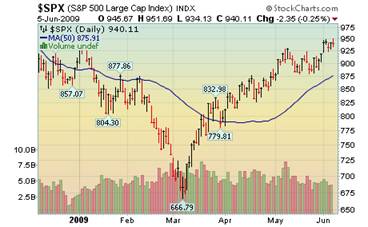 -- While the U.S. economy is showing signs of stabilizing from a recession that started in December 2007, it’s “way too early” to say the contraction is over, said the head of the group that officially makes the call. Gross domestic product estimated on a monthly basis “had a trough earlier this year, but it is way too early to say that it is a true trough rather than a pause in a longer decline,” said Robert Hall, who heads the National Bureau of Economic Research’s Business Cycle Dating Committee.
-- While the U.S. economy is showing signs of stabilizing from a recession that started in December 2007, it’s “way too early” to say the contraction is over, said the head of the group that officially makes the call. Gross domestic product estimated on a monthly basis “had a trough earlier this year, but it is way too early to say that it is a true trough rather than a pause in a longer decline,” said Robert Hall, who heads the National Bureau of Economic Research’s Business Cycle Dating Committee.
Not an improving economy (it’s not), but shrinking demand.
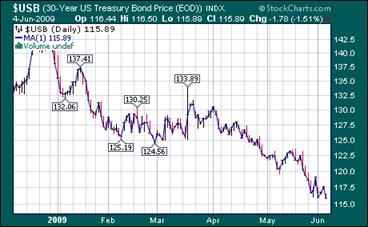 -- Treasuries fell, with 10-year yields touching the highest since November, ahead of reports expected to show employers cut the least amount of jobs this year, raising speculation the worst of the recession may be over. The difference in yield between two- and 10-year notes widened to the most on record after the Treasury said it would sell $30 billion in 10- and 30-year securities next week amid concern about shrinking demand.
-- Treasuries fell, with 10-year yields touching the highest since November, ahead of reports expected to show employers cut the least amount of jobs this year, raising speculation the worst of the recession may be over. The difference in yield between two- and 10-year notes widened to the most on record after the Treasury said it would sell $30 billion in 10- and 30-year securities next week amid concern about shrinking demand.
Gold breaks out to new high.
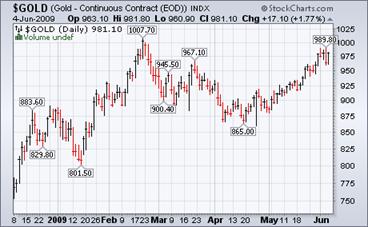 Gold fell in early Asian trading as an advance in the dollar reduced demand for the metal as an alternative investment. Bullion fell as much as 0.3 percent on a recovery in the U.S. currency. The precious metal typically moves in the opposite direction to the dollar. Holdings in the SPDR Gold Trust, the biggest exchange- traded fund backed by bullion, were unchanged at 1,132.5 metric tons as of yesterday, according to the company’s Web site.
Gold fell in early Asian trading as an advance in the dollar reduced demand for the metal as an alternative investment. Bullion fell as much as 0.3 percent on a recovery in the U.S. currency. The precious metal typically moves in the opposite direction to the dollar. Holdings in the SPDR Gold Trust, the biggest exchange- traded fund backed by bullion, were unchanged at 1,132.5 metric tons as of yesterday, according to the company’s Web site.
Japanese stocks near end of rally.
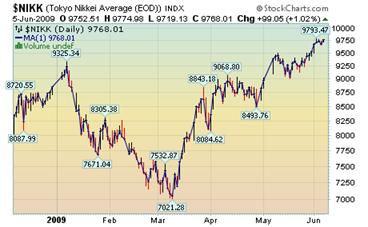 -- Japanese stocks rose, Friday, helped by gains in oil stocks as well as banks after their U.S. counterparts gained in overnight trading. The market opened higher and stayed in a narrow range as investors await May U.S. jobs data due out later in the global trading day. "Investors didn't want to hold large positions over the weekend while U.S. employment data concerns remain," said Yutaka Miura, senior technical analyst at Mizuho Securities.
-- Japanese stocks rose, Friday, helped by gains in oil stocks as well as banks after their U.S. counterparts gained in overnight trading. The market opened higher and stayed in a narrow range as investors await May U.S. jobs data due out later in the global trading day. "Investors didn't want to hold large positions over the weekend while U.S. employment data concerns remain," said Yutaka Miura, senior technical analyst at Mizuho Securities.
China’s economists raise growth forecasts.
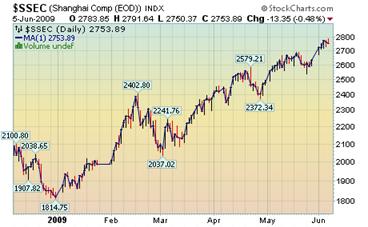 -- China’s Shanghai Index fell for a second day, paring a weekly advance, as financial companies declined on speculation this year’s rally has priced in prospects for earnings recovery. The Shanghai gauge advanced 4.6 percent this week, its fifth weekly gain in six, on signs the economy is recovering. Manufacturing grew for a third month, government data showed June 1, triggering a 3.4 percent gain on the equity index. Still, the government said yesterday unemployment is worsening, a quick rebound in trade is becoming less likely, and the nation is yet to feel the full effects of a global slump.
-- China’s Shanghai Index fell for a second day, paring a weekly advance, as financial companies declined on speculation this year’s rally has priced in prospects for earnings recovery. The Shanghai gauge advanced 4.6 percent this week, its fifth weekly gain in six, on signs the economy is recovering. Manufacturing grew for a third month, government data showed June 1, triggering a 3.4 percent gain on the equity index. Still, the government said yesterday unemployment is worsening, a quick rebound in trade is becoming less likely, and the nation is yet to feel the full effects of a global slump.
Experts still predicting the dollar decline.
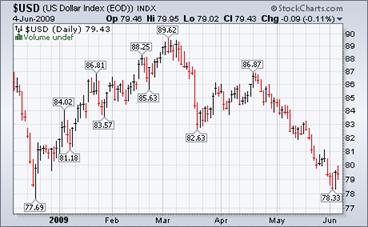 -- The dollar may keep falling against the euro in the short term, according to UBS AG, the world’s second-biggest currency trader.
-- The dollar may keep falling against the euro in the short term, according to UBS AG, the world’s second-biggest currency trader.
“While we view the next big move as towards dollar strength, beyond today short-term catalysts are hard to find and this weak dollar run could go a little further than we thought,” Geoff Kendrick, a currency strategist in London, said in a report today.
Mortgage rates rising, if you can get them.
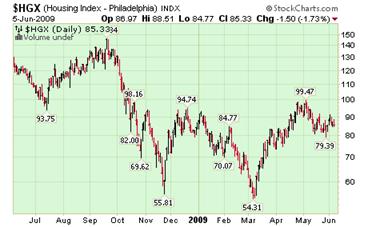 If you're looking for a new 30-year mortgage, last week's events from the financial markets carry a very simple message: Get 'em cheap while you still can. Rates on conforming 30-year loans jumped dramatically in just a few days, ending the week at an average of 5.27% according to Bankrate.com. That's still OK by historic standards, but it's a jump from the levels seen just a few weeks ago, when you could get loans at 4.75% or below. The yield on the 10-Year Treasury, which was barely 2% near the end of last year, surged to 3.67% late last week before settling back slightly. And that, in turn, pushes up rates on other long-term loans.
If you're looking for a new 30-year mortgage, last week's events from the financial markets carry a very simple message: Get 'em cheap while you still can. Rates on conforming 30-year loans jumped dramatically in just a few days, ending the week at an average of 5.27% according to Bankrate.com. That's still OK by historic standards, but it's a jump from the levels seen just a few weeks ago, when you could get loans at 4.75% or below. The yield on the 10-Year Treasury, which was barely 2% near the end of last year, surged to 3.67% late last week before settling back slightly. And that, in turn, pushes up rates on other long-term loans.
Crude oil driving gasoline prices higher.
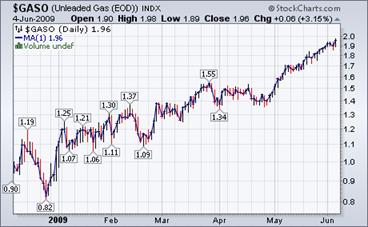 Energy Information Administration Weekly Report suggests that, “For the first time since October 27, 2008, the national average price for regular gasoline exceeded $2.50 a gallon. Gaining nearly nine cents, the average price jumped to $2.52 per gallon. Nonetheless, even with a cumulative increase of nearly 48 cents over the past five weeks, the price remained $1.45 below a year ago. Prices increased in all regions of the country.”
Energy Information Administration Weekly Report suggests that, “For the first time since October 27, 2008, the national average price for regular gasoline exceeded $2.50 a gallon. Gaining nearly nine cents, the average price jumped to $2.52 per gallon. Nonetheless, even with a cumulative increase of nearly 48 cents over the past five weeks, the price remained $1.45 below a year ago. Prices increased in all regions of the country.”
Economic downturn reflected in natural gas prices.
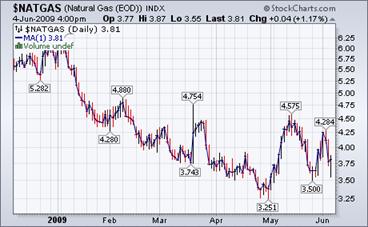 The Energy Information Agency’s Natural Gas Weekly Update reports, “Factors contributing to rising natural gas prices likely included increased cooling demand for natural gas and rising crude oil prices. Additionally, general macroeconomic conditions, including a weaker U.S. dollar and signs of an incipient recovery in the U.S. economy, appear to be contributing to the recent rally in natural gas prices.”
The Energy Information Agency’s Natural Gas Weekly Update reports, “Factors contributing to rising natural gas prices likely included increased cooling demand for natural gas and rising crude oil prices. Additionally, general macroeconomic conditions, including a weaker U.S. dollar and signs of an incipient recovery in the U.S. economy, appear to be contributing to the recent rally in natural gas prices.”
An edgy essay on the economy.
Galbraith's conclusions about the causes of the Great Depression point to why the current Depression will be deeper. (by Charles Hugh Smith)
“I hesitate to call this topic "important" because such announcements instantly cut my readership in half. Thus I am inclined to call this topic "edgy," "explosive" and "contrarian," all of which sound more interesting than "important" (yawn).”
What stuff are we made of?
J.R. Nyquist writes regularly on the web. This week’s article is especially pointed (at us).
To understand who we are, historical references are useful. To know how a people will come through a crisis, look to those traits of character possessed by nations that have snatched victory from the jaws of defeat. How did they survive their ordeal? What lessons can we draw from their story?
Our Investment Advisor Registration is on the Web
We are in the process of updating our website at www.thepracticalinvestor.com to have more information on our services. Log on and click on Advisor Registration to get more details.
If you are a client or wish to become one, please make an appointment to discuss our investment strategies by calling Connie or Tony at (517) 699-1554, ext 10 or 11. Or e-mail us at tpi@thepracticalinvestor.com .
Anthony M. Cherniawski,
President and CIO
http://www.thepracticalinvestor.com
As a State Registered Investment Advisor, The Practical Investor (TPI) manages private client investment portfolios using a proprietary investment strategy created by Chief Investment Officer Tony Cherniawski. Throughout 2000-01, when many investors felt the pain of double digit market losses, TPI successfully navigated the choppy investment waters, creating a profit for our private investment clients. With a focus on preserving assets and capitalizing on opportunities, TPI clients benefited greatly from the TPI strategies, allowing them to stay on track with their life goals
Disclaimer: The content in this article is written for educational and informational purposes only. There is no offer or recommendation to buy or sell any security and no information contained here should be interpreted or construed as investment advice. Do you own due diligence as the information in this article is the opinion of Anthony M. Cherniawski and subject to change without notice.
Anthony M. Cherniawski Archive |
© 2005-2022 http://www.MarketOracle.co.uk - The Market Oracle is a FREE Daily Financial Markets Analysis & Forecasting online publication.



